For the last two months, the Australian labour market has gone backwards. The deterioration seems…
Australian labour market – subdued and weaker in 2018
The latest labour force data released today by the Australian Bureau of Statistics – Labour Force data – for February 2018 shows that the Australian labour market labour market has weakened at the start of 2018. Employment growth was again very modest in February 2018 and participation only marginally rose. The rise in unemployment was due to employment growth failed to keep up with the underlying population growth although the slight uptick in participation exacerbated this a bit. The teenage labour market stood still although this cohort did participate in the overall full-time employment growth. Further, underemployment rose marginally as did the broad labour underutilisation rate in the three months to February 2018. Overall, my assessment is that the Australian labour market has a lot of slack remaining. It is not close to full employment yet.
The summary ABS Labour Force (seasonally adjusted) estimates for February 2018 are:
- Employment increased 17,500 (0.1 per cent) – Full-time employment increased 64,900 and part-time employment decreased 47,400.
- Unemployment increased 8,900 to 734,100.
- The official unemployment rate increased by 0.1 percentage points to 5.6 per cent.
- The participation rate rose by less than 0.1 points to 65.7 per cent. It is now approaching its previous peak (December 2010) of 65.8 per cent.
- Aggregate monthly hours worked increased 21.2 million hours (1.2 per cent).
- The estimates for the February-quarter 2018 show that underemployment rose by 12.6 thousand and was estimated to be 8.41 per cent of the labour force (up 0.1 points from November 2017). The total labour underutilisation rate (unemployment plus underemployment) was 13.9 per cent (up 0.1 points from November 2017. There were 1,107 thousand persons underemployed and a total of 1,841 thousand workers either unemployed or underemployed.
Employment growth – positive but remains subdued
Employment growth was moderate again in February with a net job increase of just 17,500 (0.1 per cent). The notable feature was that Full-time employment increased 64,900.
Part-time employment decreased 47,400.
We observed a zig-zag pattern in total employment growth up until the end of 2016 switching around the zero growth line. The oscillating pattern has continued into 2017 but the level has risen above the zero line.
The following graph shows the month by month growth in full-time (blue columns), part-time (grey columns) and total employment (green line) for the 24 months to February 2018 using seasonally adjusted data.
It gives you a good impression of just how flat employment growth had been leading into 2017 and the increasingly better performance in 2017.
Overall: today’s result signals a sustained weaker labour market.
The following table provides an accounting summary of the labour market performance over the last six months. The monthly data is highly variable so this Table provides a longer view which allows for a better assessment of the trends.
Overall there have been 161.1 thousand jobs (net) added in Australia over the last six months while the labour force has increased by 172 thousand. The result has been that unemployment has risen by 10.3 thousand.
Given the variation in the labour force estimates, it is sometimes useful to examine the Employment-to-Population ratio (%) because the underlying population estimates (denominator) are less cyclical and subject to variation than the labour force estimates. This is an alternative measure of the robustness of activity to the unemployment rate, which is sensitive to those labour force swings.
The following graph shows the Employment-to-Population ratio, since February 2008 (the low-point unemployment rate of the last cycle).
It dived with the onset of the GFC, recovered under the boost provided by the fiscal stimulus packages but then went backwards again as the last Federal government imposed fiscal austerity in a hare-brained attempt at achieving a fiscal surplus.
The ratio began rising in December 2014 which suggested to some that the labour market had bottomed out and would improve slowly as long as there are no major policy contractions or cuts in private capital formation.
The series turned again as overall economic activity weakened.
However, since February 2017 when the ratio was 61 per cent, the situation has improved somewhat and the ratio rose by 0.2 points to 62 after being stationary between August and October.
It was unchanged in February 2018 at 62 per cent and remains a 0.9 percentage points below the April 2008 peak of 62.9 per cent.
To put the current monthly performance into perspective, the following graph shows the average monthly employment change for the calendar years from 2005 to 2018 (the 2018 result is for February only).
It is clear that after some lean years, 2017 was a much stronger year if total employment is the indicator.
To provide a longer perspective, the following graphs shows the average monthly changes in Total employment (upper panel), and Full-time and Part-time employment (lower panel) in thousands since 1978 (when the current dataset began).
The 2018 average is for January and February only so is not definitive.
The interesting result is that during recessions or slow-downs, it is full-time employment that takes the bulk of the adjustment. Even when full-time employment growth is negative, part-time employment continues to grow.
Teenage labour market – 15-19 year olds endure zero employment growth
There was zero teenage employment growth in February.
Full-time teenage employment rose by 1.9 thousand in February 2018, while part-time employment fell by 1.9 thousand.
The following graph shows the distribution of net employment creation in the last month by full-time/part-time status and age/gender category (15-19 year olds and the rest)
Over the last 12 months, however, teenagers have gained 21 thousand (net) jobs overall while the rest of the labour force have gained 399.7 thousand net jobs.
Teenagers are around 6.1 per cent of the total labour force and their share in employment growth over the last 12 months has been only 5 per cent (that is, disproportionately low).
The following graph shows the change in aggregates over the last 12 months.
In terms of the current cycle, which began after the last low-point unemployment rate month (February 2008), the following results are relevant:
1. Since February 2008, there have been only 1,833 thousand (net) jobs added to the Australian economy but teenagers have lost a staggering 92.7 thousand over the same period.
2. Since February 2008, teenagers have lost 115.6 thousand full-time jobs (net).
3. Even in the traditionally, concentrated teenage segment – part-time employment, teenagers have gained only 22 thousand jobs (net) even though 940.4 thousand part-time jobs have been added overall. That is, the teenage share has been 2.4 per cent while its share of the labour force is 6.1 per cent.
To put the teenage employment situation in a scale context (relative to their size in the population) the following graph shows the Employment-Population ratios for males, females and total 15-19 year olds since February 2008.
You can interpret this graph as depicting the loss of employment relative to the underlying population of each cohort. We would expect (at least) that this ratio should be constant if not rising somewhat (depending on school participation rates).
The facts are that the absolute loss of jobs reported above is depicting a very difficult situation for our teenagers. Males, in particular, have lost out severely as a result of the economy being deliberately stifled by austerity policy positions.
In the latter months of 2015, with the part-time employment situation improving, there was some reversal in the downward trends in these ratios.
The February 2018 result showed that the male ratio fell by 0.1 points to 41.4 per cent, the female ratio fell by 0.1 points to 47.3 and the overall ratio fell by 0.1 points to 44.3 per cent.
The male ratio has fallen by 11.1 percentage points since February 2008, the female ratio has fallen by 4.8 percentage points and the overall teenage employment-population ratio has fallen by 8 percentage points.
The other staggering statistic relating to the teenage labour market is the decline in the participation rate since the beginning of 2008 when it peaked in February at 61.4 per cent.
In February 2018, the participation rate was 55.2 per cent (up 0.9 percentage points).
The difference between the 2008 level, amounts to an additional 93 thousand teenagers who have dropped out of the labour force as a result of the weak conditions since the crisis.
If we added them back into the labour force the teenage unemployment rate would be 27.9 per cent rather than the official estimate for February 2018 of 19.7 per cent.
Some may have decided to return to full-time education and abandoned their plans to work. But the data suggests the official unemployment rate is significantly understating the actual situation that teenagers face in the Australian labour market.
Overall, the performance of the teenage labour market remains fairly poor. It doesn’t rate much priority in the policy debate, which is surprising given that this is our future workforce in an ageing population. Future productivity growth will determine whether the ageing population enjoys a higher standard of living than now or goes backwards.
I continue to recommend that the Australian government immediately announce a major public sector job creation program aimed at employing all the unemployed 15-19 year olds, who are not in full-time education or a credible apprenticeship program.
Unemployment increased 8,900 to 734,100
The official unemployment rate increased by 0.1 percentage points to 5.6 per cent in February 2018 on the back of the subdued employment growth.
The following graph shows the national unemployment rate from February 1978 to February 2018. The longer time-series helps frame some perspective to what is happening at present.
After falling steadily as the fiscal stimulus pushed growth along, the unemployment rate slowly trended up for some months.
It is now still 0.6 points above the level it fell to as a result of the fiscal stimulus and 1.6 points above the level reached before the GFC began.
Conclusion: there is still considerable slack in the labour market that should be absorbed with fiscal stimulus.
Broad labour underutilisation rose to 13.9 per cent
The ABS publishes monthly and quarterly labour underutilisation data. The quarterly data for the February-quarter 2017 was published this month.
The results are:
1. Underemployment rose by 12.6 thousand and was estimated to be 8.41 per cent of the labour force (up 0.1 points from November 2017).
2. The total labour underutilisation rate (unemployment plus underemployment) was 13.9 per cent (up 0.1 points from November 2017).
3. There were 1,107 thousand persons underemployed and a total of 1,841 thousand workers either unemployed or underemployed.
So even with steady employment growth, the Australian labour market has nearly 1.9 million workers available for work who cannot find sufficient hours.
In terms of the quarterly data, the following graph plots the seasonally-adjusted underemployment rate in Australia since February 1978 to the February-quarter 2018 (blue line) and the broad underutilisation rate over the same period (green line).
The difference between the two lines is the unemployment rate.
You can see the three cyclical peaks corresponding to the 1982, 1991 recessions and the more recent downturn.
The other difference between now and the two earlier cycles is that the recovery triggered by the fiscal stimulus in 2008-09 did not persist and as soon as the ‘fiscal surplus’ fetish kicked in in 2012, things went backwards very quickly.
The two earlier peaks were sharp but steadily declined. The last peak fell away on the back of the stimulus but turned again when the stimulus was withdrawn.
If hidden unemployment (given the depressed participation rate) is added to the broad ABS figure the best-case (conservative) scenario would see a underutilisation rate well above 17 per cent at present. Please read my blog – Australian labour underutilisation rate is at least 13.4 per cent – for more discussion on this point.
The next quarterly update will be for the May-quarter 2018 and will be published published in the June 2018 Labour Force release. In between those releases, the monthly estimates will guide our thinking.
Hours worked – increased 21.2 million hours (1.2 per cent)
The decline in working hours is consistent with the sharp fall in full-time employment and the rising underemployment as a result of the renewed bias towards part-time work.
This is now the second consecutive month that working hours have fallen in total.
Again, a sign of a weakening labour market.
The following graph shows the monthly growth (in per cent) over the last 24 months. The dark linear line is a simple regression trend of the monthly change – which depicts an modest upward trend – distorted somewhat by the outlier in May 2017 (the trend would have been more sharply downward without that positive spike).
You can see the pattern of the change in working hours is also portrayed in the employment graph – zig-zagging across the zero growth line although less so in 2017.
Conclusion
My standard monthly warning: we always have to be careful interpreting month to month movements given the way the Labour Force Survey is constructed and implemented.
Today’s figures show that the Australian labour market has steadied in the first two months of 2018 in a weaker state compared to 2017.
Employment growth was again very modest in February 2018 and participation barely moved.
The rise in unemployment was due to employment growth failed to keep up with the underlying population growth although the slight uptick in participation exacerbated this a bit.
The teenage labour market stood still although this cohort did participate in the overall full-time employment growth.
Further, underemployment rose marginally as did the broad labour underutilisation rate in the three months to February 2018.
Taken together, my overall assessment is:
1. The labour market weakended a bit at the start of 2018.
2. It remains a considerable distance from full employment.
That is enough for today!
(c) Copyright 2018 William Mitchell. All Rights Reserved.
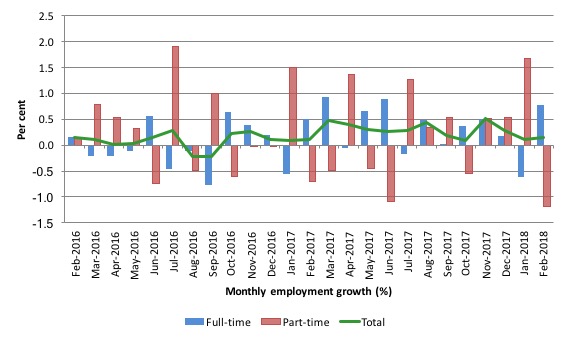
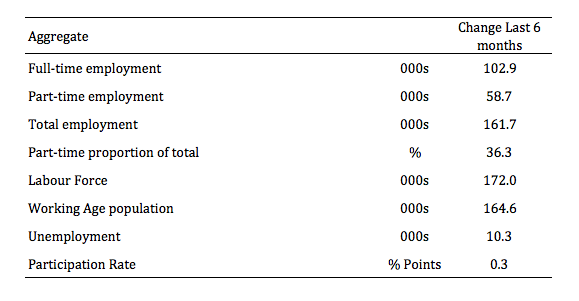
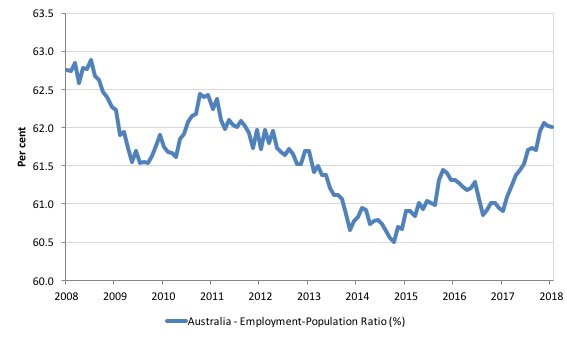
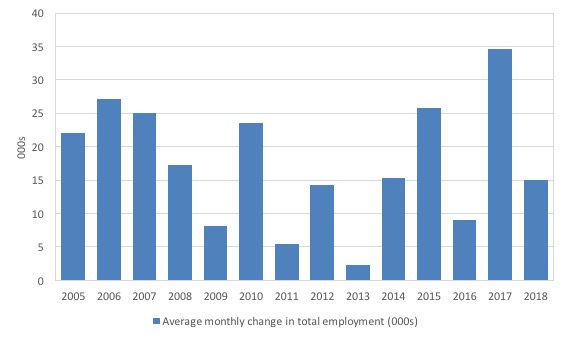
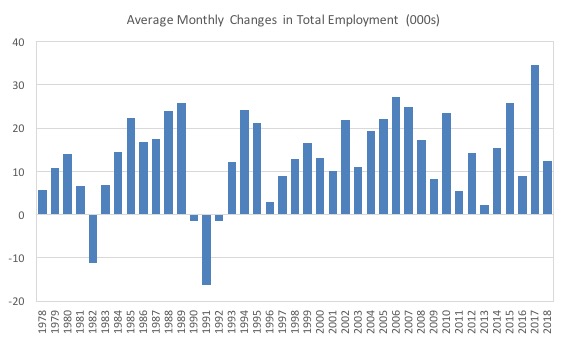
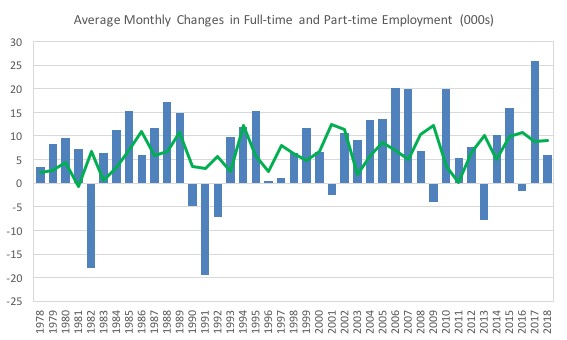
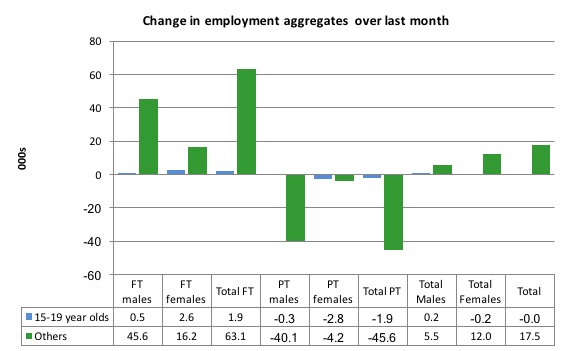
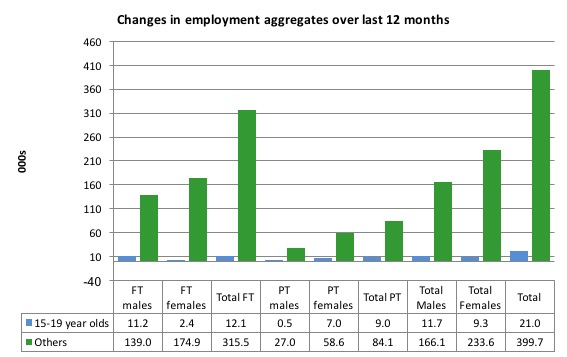
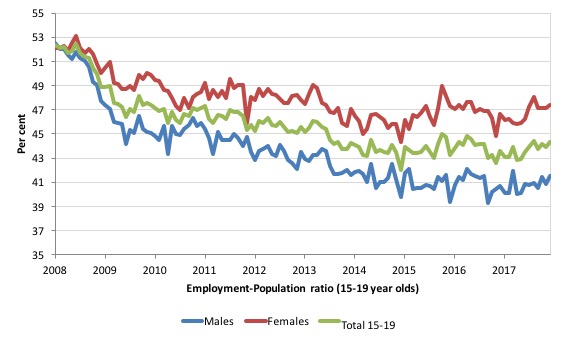
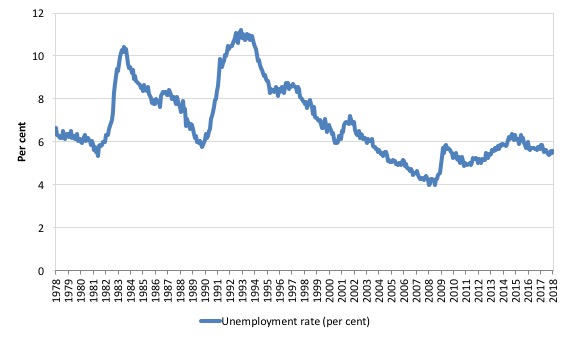
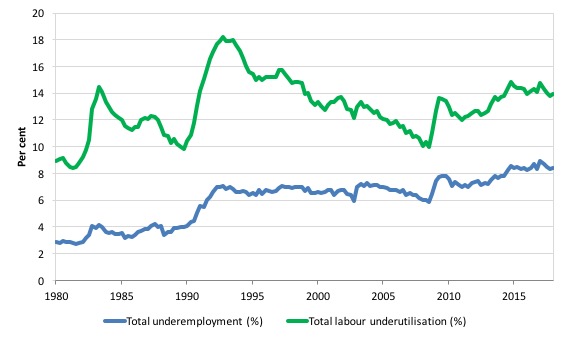
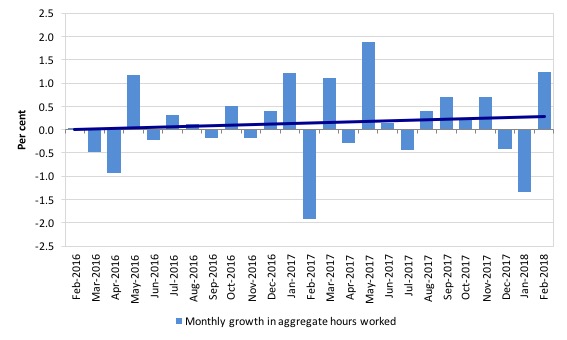
This Post Has 0 Comments